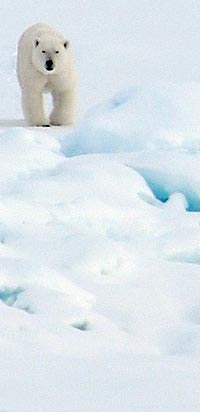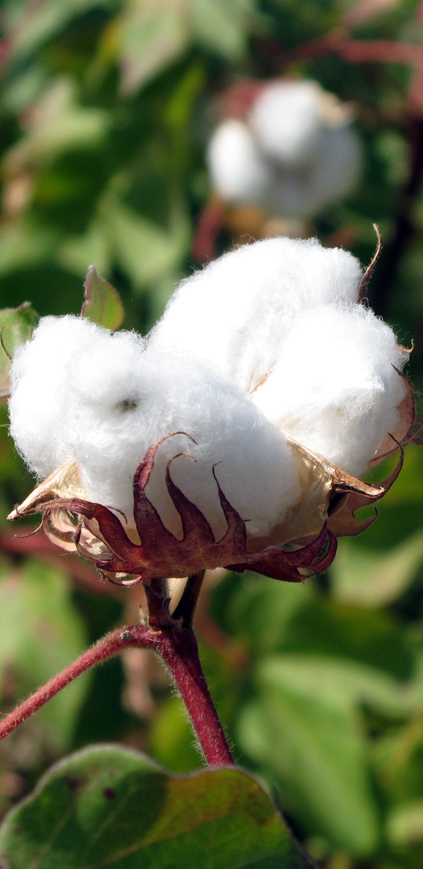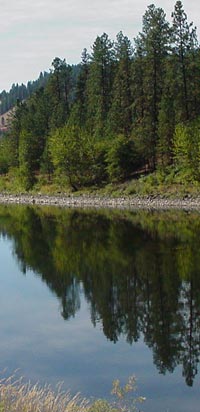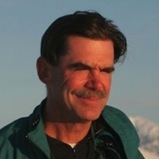
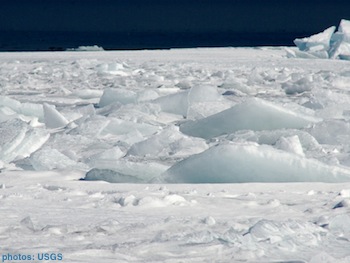 Satellite data show that Arctic ice continues to melt, and 2011 may be another record-breaking year.
Satellite data show that Arctic ice continues to melt, and 2011 may be another record-breaking year.
While researchers are already observing impacts on the migration and reproductive patterns of marine and terrestrial animals — including humans — another group of scientists is detecting the ''remobilization'' of pollutants that settled in Arctic ice and soil in the 20th century but may now create a health hazard.
There are many uncertainties about Arctic sea ice dynamics and projections about sea ice cover in coming decades. While scientists are confident that the decline in ice during the satellite era is related to human-made climate change, they still have many questions about the extent to which natural fluctuations in ocean currents and weather patterns are reinforcing sea ice loss. For example, they’ve recently discovered that an ocean/atmosphere cycle known as the Arctic Dipole Anomaly can accelerate ice loss. But what drives this pattern and how it will behave in the future are unclear.
Setting it straight: When skeptics of human-made climate change hear mention of Arctic sea ice decline, they often bring up the fact that Antarctic sea ice is actually growing in some areas. But the trends we’re seeing now at both poles are consistent with physical science and computer model projections of a warming world.
I’ll be watching: August and September are typically when we see the annual Arctic sea ice minimum. Some projections predict that the sea ice extent this year will drop below 2007’s record low levels. However, regardless of whether this year turns out to be one for the record books, the long-term trend is what’s important, and that trend is decline.
Read more about this topic
The marine environments of the Arctic and Antarctic have evolved over eons to be dependent on the seasonal formation and retreat of sea ice. Now that sea ice is rapidly melting in the Arctic and parts of Antarctica, everything from phytoplankton to whales is affected. Along the Antarctic Peninsula, the life history of Antarctic krill is intimately intertwined with sea ice. The tiny invertebrates are near the base of the food chain, and they appear to be in decline in some sectors of the Southern Ocean. In parts of the Arctic, the earlier retreat of sea ice in spring has been bad for some bottom-dwelling creatures, including clams, but good for some fish and whale species, such as bowhead whales, which live in the middle to upper layers of the ocean.
I was surprised to learn … how closely the reproductive cycle of polar marine creatures is tied to the timing of seasonal ice retreat. As climate change interferes with that age-old season choreography, some species are suffering, while others are benefitting from the new regime.
Notable quote: “There is definitely large-scale ecosystem change, and where it’s heading, nobody knows.” – Martin Montes-Hugo, an oceanographer at the University of Quebec.
Read more about this topic
- A World Centered on Sea Ice Is Changing Swiftly at the Poles [By Fen Montaigne, Yale Environment 360]
- As Arctic Ice Shrinks, Pacific Species Invade Atlantic, Causing Ecological ‘Tumult’ [By Michael Ricciardi, Reuters]
- Longest Polar Bear Swim Recorded—426 Miles Straight [By Anne Casselman, National Geographic News]
- Polar Bear Cubs Drowning Due to Sea Ice Loss, Says Report [By Bruce Barcortt, The Guardian]
This study found evidence that rising temperatures are sending back into the atmosphere two types of persistent organic pollutants (POPs) once stored in Arctic ice, snow, soil, and water: polychlorinated biphenyls (PCBs) and hexachlorobenzene. But scientists who monitor the Arctic environment say climate change could also worsen POP pollution from another well-known source. The Stockholm Convention, the international treaty that banned the production and use of most POPs, allows limited use of the pesticide DDT to fight malaria. With warming expected to encourage the spread of malaria-carrying mosquitoes, POP experts believe the global demand for DDT will rise – and some of that DDT will make its way to the Arctic.
I was surprised to learn: POPs have never been used in the Arctic. They chemicals detected in the far north are carried there from lower latitudes by wind and ocean currents.
Notable quote: Study author Hayley Hung told me that her work, which found evidence of re-release of these chemicals into the Arctic, creates more questions than it answers. “How much is actually there that is available for remobilization?" she asked. "How much is eventually going to deposit back out of the air? Where might it go?”
Read more about this topic
- Climate Change 'Remobilizes' Long-Buried Pollutants as Arctic Ice Melts [By Lauren Morello, The New York Times]
- Melting Arctic Ice Releasing Banned Toxins, Warn Scientists [By Damian Carrington, The Guardian]
- Climate Change Could Release Toxins Trapped in Arctic Ice [By Susanne Rust, California Watch ]
- Another Symbol of the Arctic's Complex Ecosystem Finds Itself on Thin Ice [By Lauren Morello, The New York Times]
While indigenous peoples like the Inupiat are no strangers to change, Arctic warming will have very real impacts on daily life in Alaska and elsewhere. There have been incidents of indigenous Alaskans falling through unpredictable patches of sea ice, sometimes with fatal consequences. Many communities located along the coast will be relocating to sites miles inland, and residents there will need to adjust to no longer being coastal people. But while ice loss may threaten traditional hunting practices, it will also open up new shipping routes to the Arctic, something that many northerners, including indigenous people, hope will bring in badly needed revenue.
Uncovered past: Erosion in the Arctic often acts like a clumsy archaeologist, digging up historic and cultural landmarks for scientists. That’s not necessarily a good thing since many important sites, including indigenous burial grounds, are being lost to the sea.
Baby, it’s cold outside: Arctic research is hard: It’s cold, mucky, and expensive. Those difficulties mean that a lot of the Arctic’s mysteries — whether it’s how ice melts or how ecosystems flourish or languish — remain unsolved.
Read more about this topic
| Tweet This Page |


